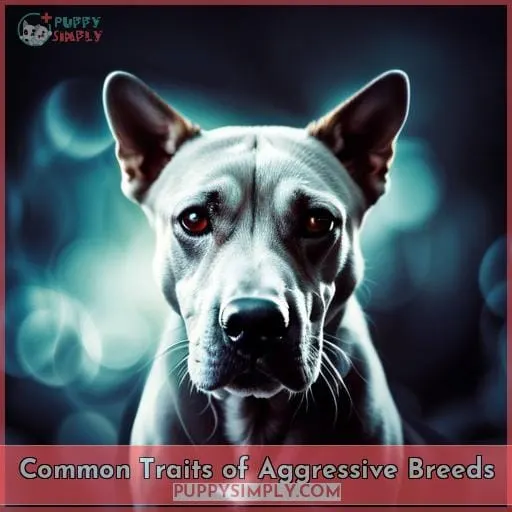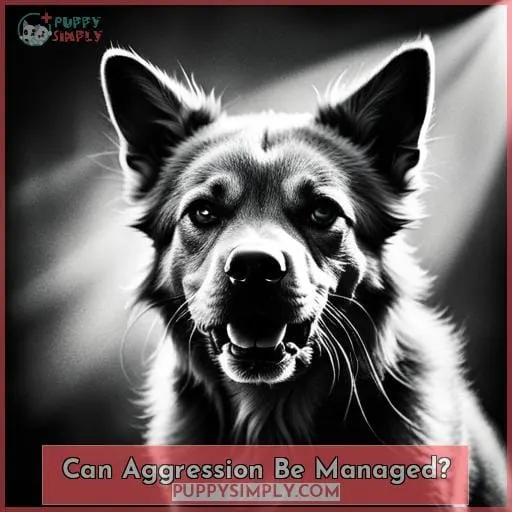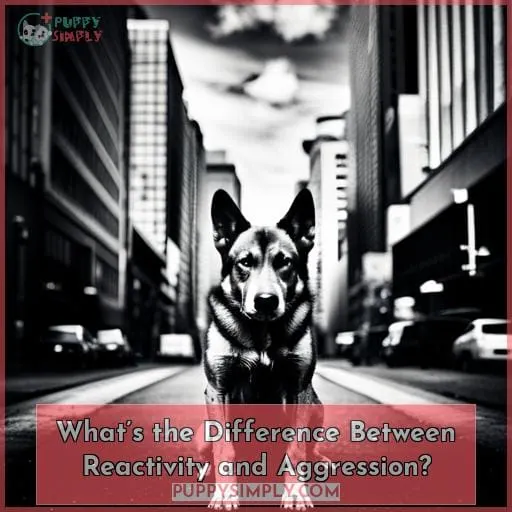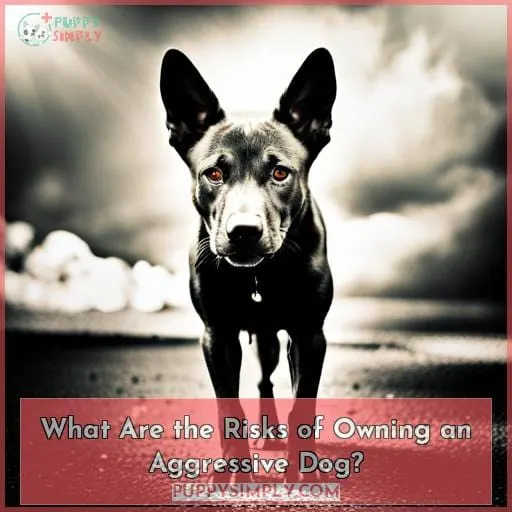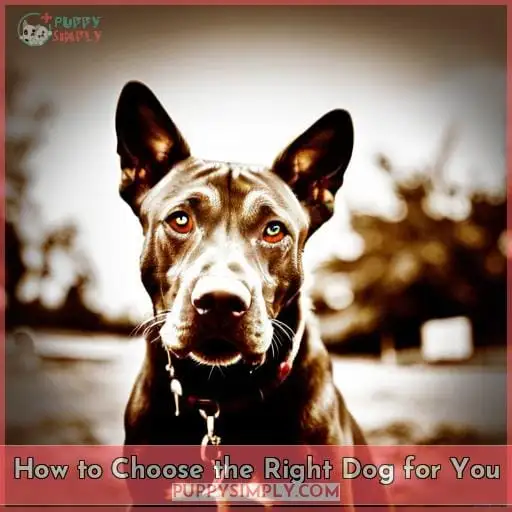This site is supported by our readers. We may earn a commission, at no cost to you, if you purchase through links.
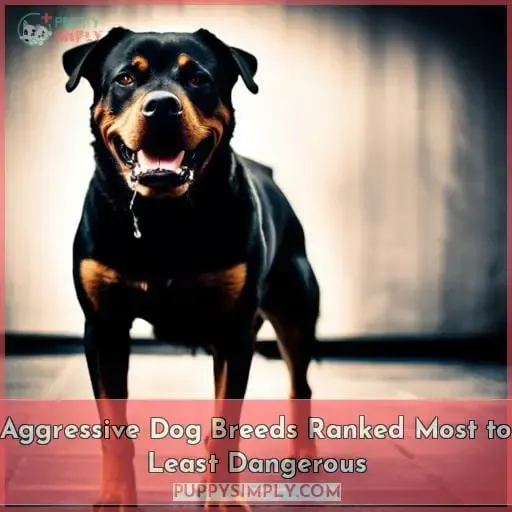 Imagine a dog, its teeth bared, eyes blazing with fury, ready to attack.
Imagine a dog, its teeth bared, eyes blazing with fury, ready to attack.
These are the most aggressive dog breeds, known for their unpredictable and sometimes violent behavior.
From the tiny Chihuahua to the massive Pit Bull, these breeds can cause serious injury or even death.
In this article, we’ll delve into the world of aggressive dog breeds, ranking them from most to least dangerous.
We’ll explore the factors that contribute to aggression, the risks of owning an aggressive dog, and how to choose the right dog for you.
Table Of Contents
- Key Takeaways
- Why Are Some Dogs Aggressive?
- Most Aggressive Small Dog Breeds
- Most Aggressive Medium Dog Breeds
- Most Aggressive Large Dog Breeds
- Common Traits of Aggressive Breeds
- Can Aggression Be Managed?
- What’s the Difference Between Reactivity and Aggression?
- Are Some Breeds Inherently More Dangerous?
- What Are the Risks of Owning an Aggressive Dog?
- How to Choose the Right Dog for You
- Frequently Asked Questions (FAQs)
- Conclusion
Key Takeaways
- Certain breeds like Chihuahuas, Chow Chows, Pit Bulls, and Rottweilers tend to be more aggressive due to genetics and breeding purposes.
- Breeds that are naturally dominant, territorial, distrustful, or protective require more extensive training and proper socialization to mitigate aggressive tendencies.
- Small breeds may become aggressive due to fear or lack of training related to their size, while large breeds can be more dangerous due to their strength and power.
- Selecting compatible breeds by considering lifestyle, experience level, breed tendencies, and docile temperaments can help manage and prevent aggressive behavior.
Why Are Some Dogs Aggressive?
When looking at aggressive dog breeds, it’s important to consider genetics, training, health, and environment as factors.
Certain breeds may be predisposed towards aggression due to breeding purposes like guarding, hunting, or fighting.
However, proper training, socialization, exercise, and a stable environment can help mitigate aggressive tendencies in dogs.
Genetics
You’ll find that some dogs are genetically predisposed to aggression because they were selectively bred for traits like protectiveness, high prey drive, and fighting ability.
Aggression arises from genetic tendencies shaped by breeding over generations for specific purposes and tasks.
However, genetics alone don’t determine a dog’s behavior.
Socialization, training, health, and other factors significantly influence aggressiveness.
Training
Despite proper socialization and training, some dogs’ aggressive tendencies can be exacerbated by inadequate or inappropriate handling.
Socialization and obedience training are key for aggressive breeds, but training techniques must match the dog to prevent inciting the wrong behaviors.
Health
Chronic pain from health issues like arthritis can make your dog more prone to aggressive behavior.
Health risks that may contribute to aggression include:
- Chronic pain from arthritis or injuries
- Underlying neurological conditions
- Side effects of medications
Management requires consulting a veterinarian to identify and address medical factors influencing behavior.
Environment
Your dog’s environment can cause aggressive behavior if it experiences chronic stress from:
- Confinement
- Isolation
- Lack of stimulation
- Threatening situations that trigger a defensive response.
| Source of Stress | Impact | Solution |
|---|---|---|
| Confinement | Boredom, frustration | More exercise, enrichment |
| Isolation | Fear, anxiety | Positive socialization |
| Lack of stimulation | Destructive behavior | Games, training, toys |
| Threatening situations | Fight or flight response | Remove from trigger, countercondition |
Most Aggressive Small Dog Breeds
You should bear in mind that small breeds like Chihuahuas and Dachshunds can demonstrate aggressive tendencies.
Their diminutive size doesn’t preclude aggressive behavior – Chihuahuas, in particular, have a reputation for aggressiveness possibly stemming from fear or lack of training.
However, appropriate socialization and responsible ownership can mitigate aggression issues regardless of a dog’s size.
Chihuahua
You’re likely familiar with Chihuahuas’ tendency to be snippy.
Given their small size yet bold personalities, they are prone to aggressiveness.
Despite their diminutive stature, Chihuahuas have an oversized personality and will energetically defend their territory.
Providing proper socialization, training, and a stable environment can help mitigate their aggressive behavior.
Their health, size, and temperament require dedicated Chihuahua owners willing to invest time into training tips for these affectionate yet sometimes overly protective small dogs.
Dachshund
When dealing with a Dachshund, aggression can arise due to their small size and dominant personality.
This short-legged, long-bodied breed is known for its unique appearance and weighs 15-30 pounds.
Dachshunds can show aggressive behaviors due to their fearless nature despite their small stature, refusing to back down from a fight.
Providing proper training and socialization is key to curbing aggression in Dachshunds.
Their possessive instincts mean they may lash out if they feel threatened.
With dedication to positive reinforcement training methods and building confidence, Dachshunds can become devoted companions.
Most Aggressive Medium Dog Breeds
Let’s move on to discussing some aggressive medium-sized dog breeds.
The Chow Chow and Akita are two examples that can demonstrate aggressive tendencies due to their protective natures and backgrounds as guard dogs.
We’ll analyze the factors that contribute to their potential aggressiveness next.
Chow Chow
Frequently, you’re dealing with a naturally aggressive and dominant personality when owning a Chow Chow, leading them to require dedicated training and proper socialization.
As a breed with aloof and aggressive tendencies, Chow Chows present specific challenges for owners to prevent problematic behavior.
Through rigorous obedience training, consistency, socialization, and responsible ownership, owners can mitigate their strong-willed temperament.
Akita
The second most aggressive medium breed dog is the Akita.
With average heights of 23 to 28 inches and weights between 60 to 100 pounds, they’re large, powerful dogs originally from Japan with innate tendencies to be territorial and distrustful, especially needing experienced handlers to provide intense training.
- Require consistent, firm training
- Territorial, protective instincts
- High prey drive
- Aloof, aggressive tendencies
Most Aggressive Large Dog Breeds
The Pit Bull and Rottweiler are two of the most aggressive large dog breeds.
They’re known for their strength, power, and tendency to attack without provocation.
These breeds require experienced owners who can provide them with the proper training and socialization.
Pit Bull
Viewed as dangerous yet owned widely, pit bulls test your ability for proper management.
With their muscular frames bred originally for dog fighting, they yield strong bites.
Despite breed stereotypes, this loyal breed thrives with training in responsible hands.
Mitigating risks through precautions allows safe ownership where permitted.
Firm leadership counters their strength stemming from breeding for tenacity, while socialization focuses powerful protectiveness beneficially.
Rottweiler
When choosing an aggressive breed like the Rottweiler, you’ll contend with strong protective instincts stemming from their history as guard dogs.
Require extensive training and socialization from an early age to mitigate territorial behavior and aggression towards strangers.
Prone to health issues like hip and elbow dysplasia that can cause chronic pain and irritability.
Need sufficient physical and mental stimulation to prevent boredom and destructive behavior.
React strongly to perceived threats so must be properly introduced to unfamiliar people and animals.
Common Traits of Aggressive Breeds
You’d find several shared tendencies among aggressive dog breeds, including:
- Jealousy
- Dominance
- Protectiveness
- A history of being bred for fighting or guarding
Aggressive breeds often display:
- Jealousy and possessiveness towards their owners
- A dominant personality that can translate to aggressive behavior
These breeds have strong protective instincts due to their breeding history for functions like:
- Guarding property
- Police work
- Participating in blood sports like dog fighting
Without proper socialization and training, these natural tendencies can result in greater aggression.
Establishing leadership, providing mental stimulation, managing the environment, and reinforcing desired behaviors through positive reinforcement can help mitigate the risks associated with aggressive breeds’ innate dispositions.
Can Aggression Be Managed?
When owning an aggressive breed, proper socialization and management of their environment are key to reducing aggressive tendencies.
This involves:
- Providing obedience training
- Minimizing exposure to triggers that elicit aggressive responses
- Maintaining firm leadership to establish yourself as the alpha
Consultation with professional dog trainers can also assist owners in implementing effective behavior modification techniques tailored to their dog’s specific needs.
Socialization
Aggression can indeed be managed if you properly socialize your dog from puppyhood.
Exposing puppies to various people, animals, and environments during their critical development window from 3 to 14 weeks shapes behavioral responses.
Continue reinforcing positive social interactions through obedience training and controlled meetups.
Immersing your dog in diverse canine interactions and structured training curbs aggression by building confidence and appropriate reactions.
Management
Focusing on you, aggression can often be managed with:
- Consistent socialization
- Strict training techniques
- Actively modifying the dog’s environment
- Begin training and socializing puppies early.
- Address anxiety triggers like loud noises or strangers.
- Provide plenty of exercise and mental stimulation.
- Consider a professional trainer or behaviorist for extra help.
What’s the Difference Between Reactivity and Aggression?
Frequently, you’ll notice your dog overreacting to common stimuli without actually exhibiting aggressive behavior.
Reactivity describes a dog that barks, lunges, or growls at triggers like people, dogs, or loud noises.
Reactive dogs need more training, desensitization, and behavioral interventions. Use positive reinforcement to change their association with triggers.
While reactive dogs appear aggressive, they don’t intend harm.
Aggression involves deliberate attempts to dominate, threaten, or harm.
Evaluating reactivity versus aggression allows proper training methods to reduce problematic behaviors, avoiding risks from true aggression.
Understanding the difference can prevent mistakenly labeling breeds as dangerous.
Are Some Breeds Inherently More Dangerous?
You’re likely wondering if certain breeds pose more risk than others when it comes to aggressive behavior.
Genetics – Some dogs were historically bred for fighting or guarding, influencing temperament.
Instincts – High prey drives in terriers for hunting increase tendency towards aggression.
Physical Traits – Jaw strength and bite power in muscular, sturdy breeds like pit bulls and rottweilers.
Trainability – Stubborn, independent thinking breeds like huskies require more diligent training.
However, any dog can become aggressive without proper socialization, training, and responsible ownership.
While genetics and history can influence temperament, conscientious owners can successfully manage behaviors in any breed through dedication and care.
What Are the Risks of Owning an Aggressive Dog?
Owning an aggressive dog comes with inherent risks, particularly in terms of legal liability and insurance.
If your aggressive dog were to bite or attack someone, you could be held legally responsible for any injuries or damages caused.
Additionally, some insurance companies may refuse coverage or charge higher premiums if they deem your dog to be a high-risk breed.
It’s important to consider these potential risks before deciding to own an aggressive dog.
Legal Liability
If you’re attacked by an aggressive dog, you’ll quickly face legal and financial consequences.
Liability:
- Owner negligence lawsuits
- Criminal charges
- Insurance claims
- Court-ordered euthanasia
Cost:
- Medical bills
- Lost wages
- Legal fees
- Higher insurance premiums
Prevention:
- Proper containment of dog
- Socialization and training
- Following leash laws
- Seeking professional help
Insurance
Insurance companies may have breed restrictions.
Dogs with a bite history are often uninsurable.
Aggressive breeds may face high premiums or denial.
How to Choose the Right Dog for You
- Consider your lifestyle and living situation to determine compatibility with more aggressive breeds.
- Mitigate risks by providing proper training, socialization, stimulation, and professional help if needed.
- Selecting an appropriate breed and managing behavior can lead to a fulfilling life with your canine companion.
Managing Aggressive Behavior
Managing aggressive behavior includes:
- Selecting more compatible breeds
- Mitigating risk factors
- Properly training your dog
Training Techniques:
- Positive reinforcement
- Consistency
- Professional trainers
Behavioral Health:
- Exercise
- Enrichment toys
- Reduce anxiety
Selecting Compatible Breeds
Several important factors must be considered when selecting a dog breed:
- Avoid getting an aggressive one incompatible with your lifestyle and experience.
- Carefully research a breed’s behavior tendencies, exercise needs, and trainability.
- Prioritize breeds with more docile temperaments, especially for first-time owners.
Provide proper socialization and training tailored to the breed:
- Consider your time commitment for exercising and stimulating the dog.
With research and preparation, you can find a compatible non-aggressive breed fitting your lifestyle.
Mitigating Risk Factors
When adopting an aggressive breed, preparing its environment and providing proper socialization can mitigate risk factors.
Leash-walking, obedience training, and socializing your puppy or dog with children and other dogs can help manage aggressive tendencies and reduce risks.
Prioritizing space for exercise, managing stimulation, and cross-training with puzzle toys and chews reinforces training for high-risk breeds.
Selecting breed-compatible homes and handling aggressive dogs responsibly are key for mitigating risk.
Frequently Asked Questions (FAQs)
Are mixed breed dogs as aggressive as purebreds?
There is no evidence that mixed breeds are inherently more or less aggressive than purebreds.
A dog’s temperament depends more on socialization, training, and responsible ownership than its genetic mix.
Focus on choosing the right individual dog for your lifestyle, not its breed makeup.
Can neutering reduce aggression in male dogs?
Yes, neutering can reduce aggression in male dogs by decreasing testosterone levels.
However, for dogs with dominance aggression, neutering may be less effective.
Consistent training and proper socialization are still essential.
What are signs of aggression in puppies?
Watch for tension, freezing, staring, lip lifting, growling, snapping when the pup interacts.
Redirect the pup’s focus gently.
Consult a trainer if concerning behavior persists, as early positive intervention helps minimize aggression long-term.
How can I find a dog trainer who specializes in aggression?
Finding a qualified dog trainer skilled in managing aggression requires:
- Asking shelters, rescues, and breeders for referrals.
- Vetting credentials.
- Observing trainers firsthand.
- Prioritizing humane methods focused on positive reinforcement over punishment.
Is it possible to train very aggressive dogs safely at home?
Unfortunately, training very aggressive dogs safely at home is extremely difficult without professional help.
Their behavior can be unpredictable and dangerous, even with precautions.
Consult an experienced trainer or behaviorist for guidance on whether home training could work and how to do so safely.
Conclusion
When selecting a canine companion, carefully consider breed traits and your ability to manage aggression through proper training and socialization.
While genetics play a role, any dog can become aggressive without proper care.
Approach myths about dangerous breeds with skepticism.
With dedication and vigilance, even reactive dogs can become model citizens.
But the responsibility ultimately lies with the owner – so choose your new best friend wisely.





